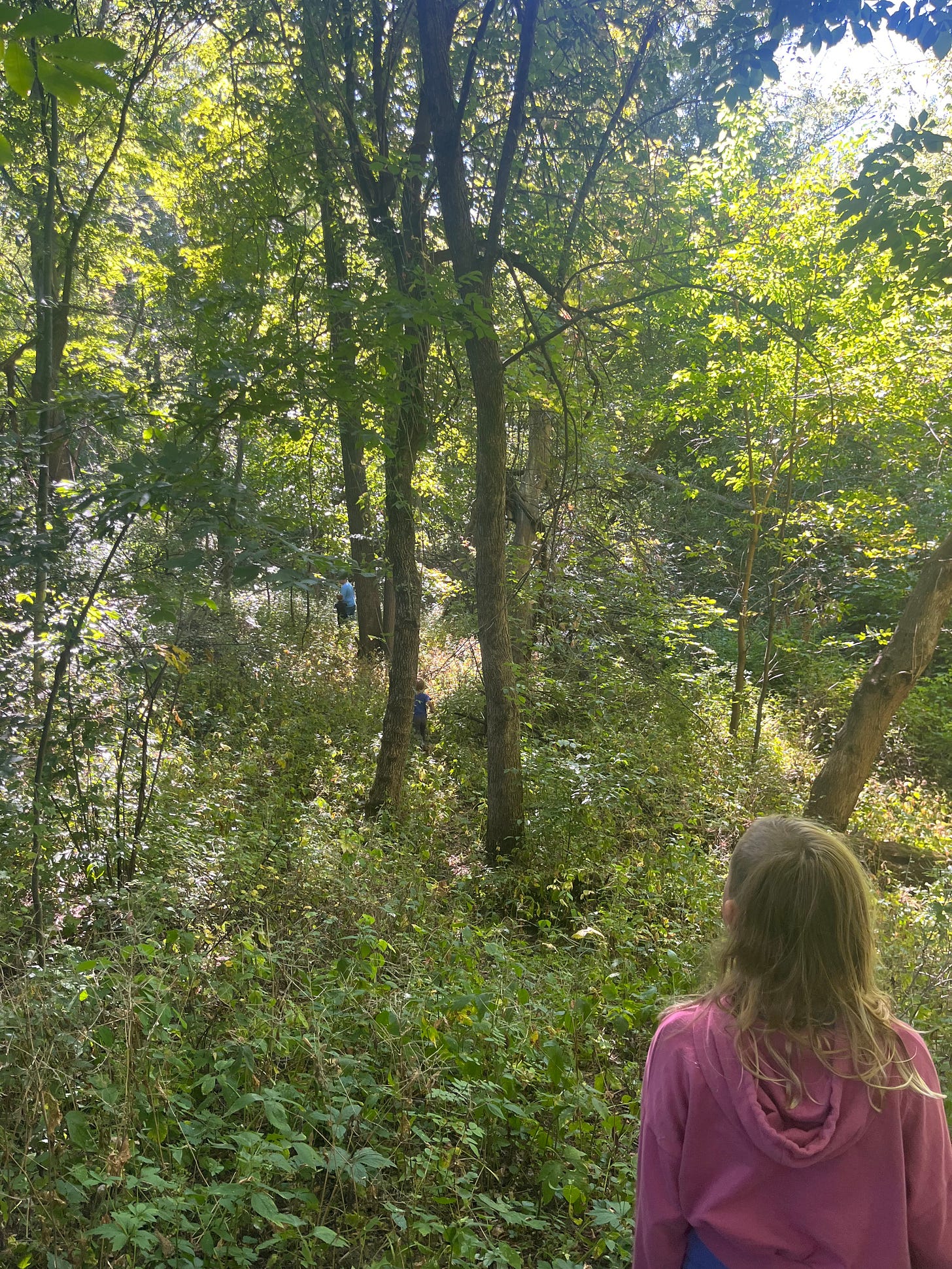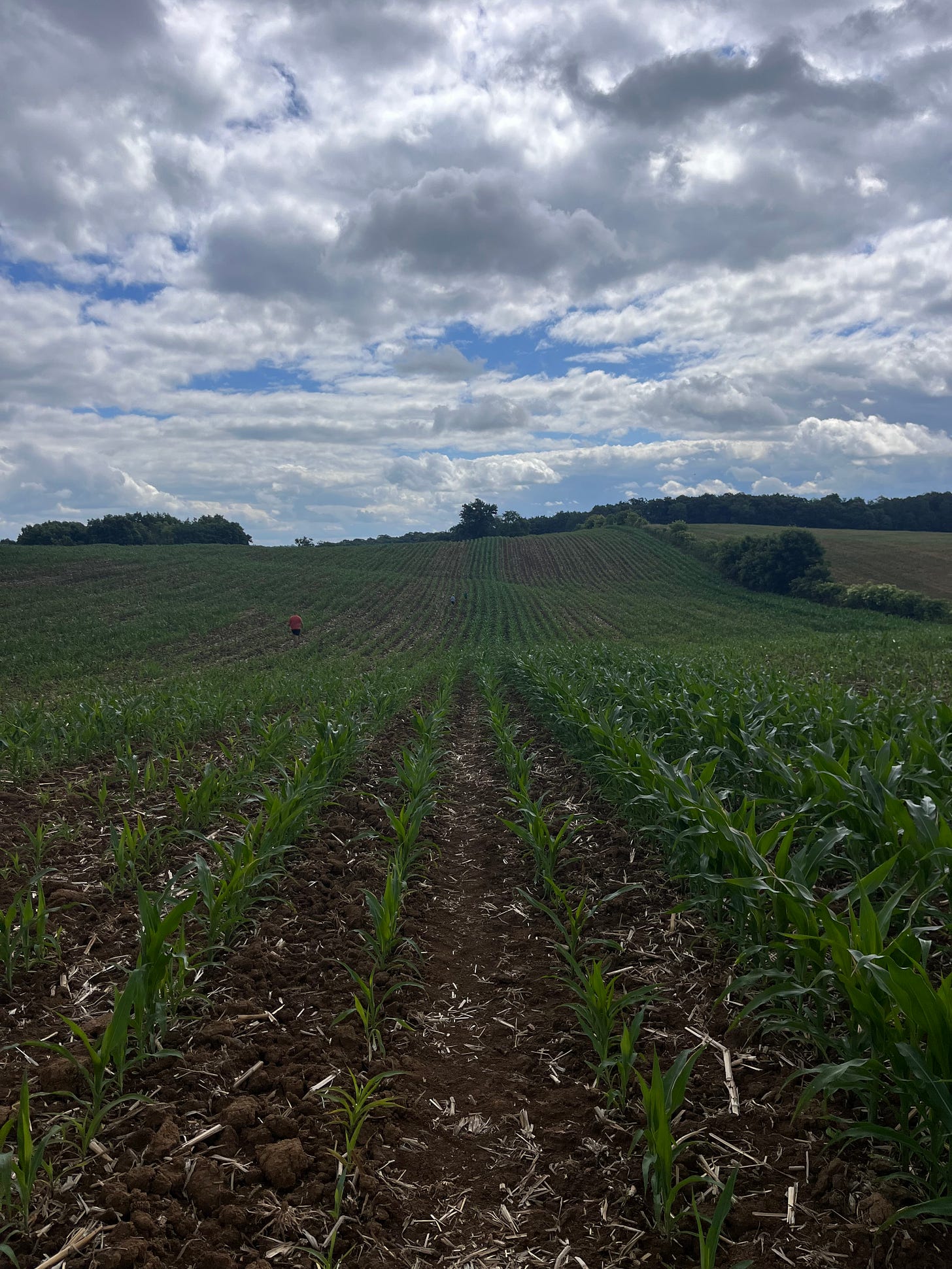I recently spent time out in the Driftless area of Wisconsin with mine and Sarah’s families. We co-purchased a 40 acre plot of land situated on a beautiful ridgetop in June of 2023. We are delighted to steward this land and to be in relationship with this place. The land is a beautiful combination of rolling hills and woods. Thirty acres are tillable land, meaning the soil has been tilled, cultivated and conventionally farmed for many years. Ten acres are woods-a mix of trees, brambles and woodland plants.
I continue to deepen into the possibility of this place, listen and pay attention to what the land wants us to know, and hold the heaviness of the history of colonization and genocide that is rooted here as well. The complexity of “owning” land is profound and something I return to again and again.
While out on the land in mid-August our families were working on creating a campsite in the woods. Part of that project includes clearing trails in the woods for access and hiking. Sarah and I (along with a handful of children) assigned ourselves to trail making duty. We headed out with hand clippers, a tool called a Trailblazer (a glorified rake that clears brush) and a sense of possibility.
The ten acres of woods are a beautiful mess of trees-oaks, birch, cottonwood, hickory and walnut, brambles like gooseberries and black raspberries and the invasive plant multiflora rose (hello massive thorns). This time of the year all of the plants are in full bloom. The woods are dense with prickly, thorny plants waiting to pierce and poke at any moment.
We weren’t totally sure where to start and found a narrow deer trail. From there it was a slow process of swiping, whacking, cutting and hacking our way through. The “progress” was slow, methodical, disorienting and a full body experience. We looked ahead of us to orient towards where we wanted to go and glanced behind us to see how far we had come. We took “wrong” turns, following and making paths that didn’t really lead to the intended destination. We sustained scrapes, bruises, and cuts from the plants we encountered and just general clumsiness around the process.
We were beginners, trying something new, learning as we went, putting in effort that felt important. What we were actually doing was a tiny, small inconsequential action, making a small path through the woods with hand tools. Yet the impact felt important.

At one point Sarah took the kids back for water and I kept working on my own. There was a focus and energy within me that felt generative. It was about the trail but so much more. I noticed the aliveness in my body and all around me-the sweat on my brow, my heart beating, breath quick from physical exertion, feet firmly planted, the sound of birdsong, trees swaying, the distant sound of kids playing (and yelling/fighting). I felt the pain of a thorn poking through my work gloves, piercing my skin.
I looked up from my clipping and cutting. Allowing my attention to expand, taking in a wider perspective. I noticed the cleared path behind me. The spaciousness of the forest, simultaneously enveloping me in her embrace. I felt held and free at the same time. I looked ahead, not sure how much farther I had to go to reach my destination. There wasn’t a clear map for this. There was trust, embodied listening, discernment. Strength and tenderness.
As I paused, I thanked this place, these woods, the trees, plants, even the brambles and “weeds” we were clearing out. Sending gratitude to this ecosystem, this perfectly imperfect place. Realizing I had started making the trail, cutting the plants, forging a path without checking in with the place, asking permission. I sent out a silent inquiry-” Is it ok to clear these paths? To remove some plants and trees to allow more life, more diversity, more beauty to flourish here?” I sensed a “yes.” A shared reverence and love for this place.1
I looked out to the farm fields where we lease the 30 acres to a farmer who has farmed the land for many years. Like most farmers in the Midwest he plants corn and soybeans, rotating the crop from year to year. I gazed upon rows and rows of soybeans planted so neatly in line. The same plant, one after another, a monoculture of expectation and standards. In the field was conformity, a pattern, a clear direction, nary a “weed” in site. There is a reason this is called conventional farming. This is the way to farm that is expected, what is generally done or assumed to be “normal.” In order to grow something, there are clear instructions, protocols, seed mixes, herbicides, pesticides and large-scale farming equipment.
I noticed the discrepancy between the woods and the tillable land. The wild, uncertain, winding path I was following through the woods versus the neat rows and order of the farm field. The metaphor was not lost on me. I love a good metaphor. (hello-inner compass)
This has felt like my journey the past few years. Finding myself in the middle of a corn or soybean field, “following the rules,” playing the part, lining up neat and tidy in my row as was expected of me. Doused in toxic systems and structures meant to keep me “alive” while slowly killing the rich darkness and depths within. I was given the conventional instructions for living a “good” life and from the outside appeared to be just fine, while slowly dying on the inside.

Now I find myself in the woods. On a path that hasn’t been cleared for me quite yet. It is messy in here, sweaty, thorny, uncomfortable, and full of vitality.
I recently heard Micheal Meade speak of the “Pathless Path.” The archetypal journey humans take when suddenly the path we have followed for so long no longer works for us. We find ourselves on a path that eventually ends, there is no longer a clear way forward. We must forge and create our own path, oriented and guided by our soulful longings and unique gifts. This can be a difficult, dark and disorienting place to be.
Where is the map?
What is the clear way forward?
What is my destination?
How do I orient myself?
Who am I becoming?
Meade says, “In the darkness we find ourselves.”

This is a place of not knowing. A place of becoming. An opportunity to stay open, listen, to be in relationship to self, community and spirit/land. I feel grateful to have the opportunity to learn from the land. To forge new paths. To create connection.
We are in the process of transitioning 15 acres of our tillable land into a native prairie. Re-wilding a portion of this place. Planting a diverse mix of seeds, wildflowers and grasses, and waiting to see what emerges from the darkness. Someday we hope to have a chance to create new paths here. Allowing ourselves and the land to be in the ongoing process of transformation and connection.
We would love to hear from you!
What new paths are your forging?
Do you find yourself in the corn or soybean field, the woods or both?
What supports you and guides you on the “pathless path”?
Upcoming Offerings:
This program is for women looking to forge a new path.
Women seeking connection to themselves, community, and spirit.
Women who want to orient themselves towards their soulful longings.
We begin in October and would LOVE to have you join us.
More info HERE
Please message us with any questions and we would be happy to chat more about the program.
This way of relating to the natural world through relationship, dialogue, consent, reciprocity and reverence is an ancient way of being that many of us have forgotten because of the legacy of colonialism and white supremacy. It is also a way that many indigenous people still practice and have never forgotten. The book Braiding Sweetgrass by Robin Wall Kimmerer has been foundational for me to relearn/unlearn a different way of relating to the world and all of her inhabitants. I highly recommend her work!




